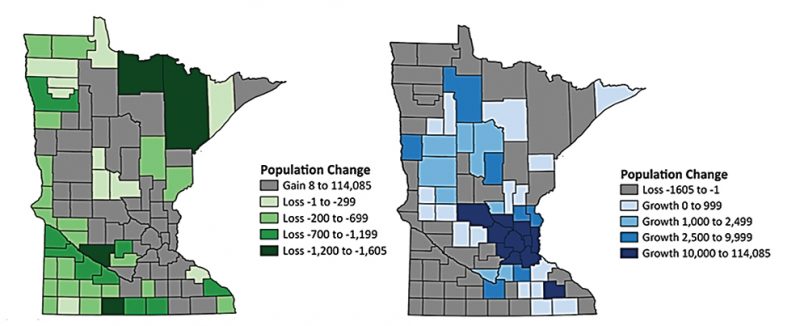Graphs from the Minnesota State Demographic Center show population growth and decline in Minnesota counties based on 2010 and 2020 census data. The metropolitan area saw the largest increase in the state, with Greater Minnesota seeing a population decline.
ST. PAUL — Data from the 2020 census shows diversity is a long-term trend in Minnesota, and an aging population could put pressure on the workforce.
Last week, Minnesota State Senior Demographer Eric Guthrie gave a presentation on the latest demographics based on 2020 census data at an annual meeting in Burnsville. A copy of his presentation was made available on a recent New Ulm Area Chamber Member Update.
According to the 2020 census, the population of Minnesota is 5.7 million. This is an increase of 346,408 residents since the 2010 census, an increase of 6.5%.
Of the 50 states, Minnesota had the 19th highest percentage increase. Texas recorded the largest overall increase in the past decade with 4.1 million residents. Illinois saw the biggest decline, losing more than a quarter of a million people.
Minnesota’s growth has been relatively small, but steady since 1990. According to census data, the state has grown by nearly one million over the past 30 years. Guthrie noted that this growth has been driven by communities of color.
All racial demographics have increased in Minnesota over the past 20 years, with the African American, Asian, and Hispanic populations more than doubling.
Since 2000, Minnesota’s African-American population has grown 130%; the Hispanic/Latino community increased by 121% and the Asian population increased by 103%.
In comparison, the white population increased by 3% during the same period.
Minnesota’s growth since the 2010 census has primarily occurred in the metropolitan area. Hennepin, Ramsey and Dakota counties grew by a combined 185,217 residents and accounted for 74.4% of the growth over the past decade.
Nicollet and Blue Earth County have also seen modest growth since 2010. Both counties have seen population increases of 1,000 to 2,000. The rest of southwestern Minnesota counties have seen population declines.
Brown and Redwood counties have lost between 700 and 1,200 people since 2010. Cottonwood and Watonwan have lost between 200 and 700 residents.
Renville County ranked among Minnesota’s top four counties for declining population. Along with Koochiching, Martin, and St. Louis counties, Renville has seen a population loss of more than 1,200 people since 2010.
Guthrie’s presentation showed that Minnesota’s population is aging, with little change in child populations. Since 1990, the state’s 18-and-over population has grown steadily, but the 17-and-under population has not changed, remaining constant at just over one million.
In 1990, the number of school-aged children (5 to 17) in Minnesota exceeded that of the population 65 and older, but as of the 2020 census, the two age groups are roughly equal .
The number of residents age 65 and older is expected to increase through 2030, but the school-age student population is not expected to increase significantly.
The impacts of an aging population could lead to reduced revenue from income and other taxes and a shift in priorities. Spending on elderly care will likely increase. Resources will be needed for those aging in place.
Minnesota isn’t the only state to see a growing population reaching retirement age. This is a national trend that is impacting the workforce for participation. It is feared that the participation rate will remain low for the foreseeable future.
According to the Minnesota Department of Jobs and Economic Development, job vacancies in the state are at an all-time high. The vacancy rate is 8%, or approximately 8 open jobs for 100 jobs.

